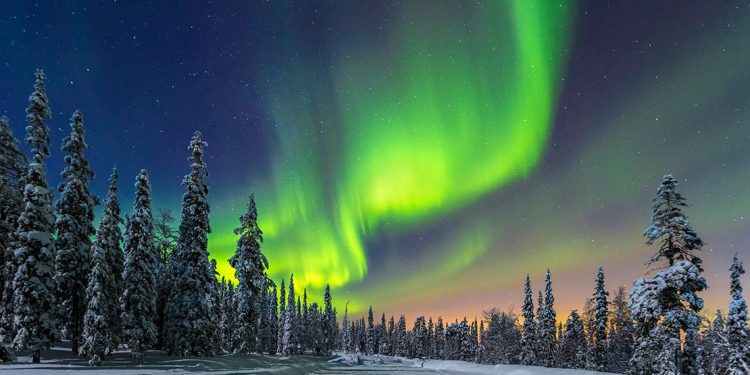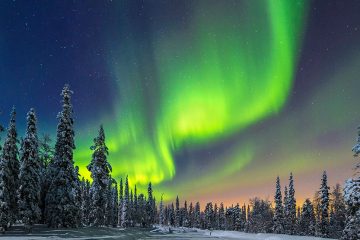
The Best Places to Witness this Beautiful Phenomenon
Nature’s very own light show is one of the most wondrous events you can ever witness. The Northern Lights are a surreal display of neon colors in the sky, appearing during the colder months in certain places in the Northern Hemisphere.
Chasing the Aurora Borealis is the pursuit of many travelers, but seeing the lights depends on many factors — location, timing, weather and a bit of luck. You can increase your chances of seeing the lights by heading to the right spots (then keep your fingers crossed for good measure). Even if you don’t see the lights, these locations are also incredible stargazing destinations, so maybe you’ll at least get a clear view of the Milky Way and a handful of shooting stars.
Pack your warm clothes and have your camera at the ready; when it comes to where to see the Northern Lights, these are the best places in the world.
Finnish Lapland, Finland
In Finnish Lapland, the Northern Lights are visible for approximately 200 nights a year. What makes Finland so special for viewing the lights isn’t just the frequency, however, but the style in which you can see them.
Finland has crafted a whole sector of accommodations around viewing the Aurora Borealis, ranging from glass igloos to luxury, glass-walled hotel suites. If seeing the Northern Lights is high on your bucket list, but you aren’t partial to the cold, Finland might be the destination for you.
You can lie back and relax in comfort as you stare up at the dark winter sky and wait for the lights to appear.
For a more adventurous experience, you can also go looking for the lights in a more traditional way — on a dog sled tour, snowshoeing or cross-country skiing.
Reykjavik, Iceland
One of the most popular destinations for spotting the Northern Lights is Iceland. The country is already mystical enough, but the aurorae will take your Icelandic experience to a whole different level of surreal.
You will need full, dark nights to get a good look at the lights, so that means visiting between September and April. The short, cold days will be worthwhile when you get a look at the lights flickering across the horizon.
From November to February, the weather is more likely to be wet or snowy, obscuring the skies and dashing your hopes of seeing the colors flash across the sky. When possible, allow a few nights for spotting the lights — then you can try again if you don’t see them the first night you go out.
From Reykjavik you can take tours to various spots across Iceland, visiting plenty of sights along the way. The fact that there are innumerable breathtaking things to do in Iceland means even if you don’t catch the lights, you’ll have plenty of other great memories from the trip to reflect on.
Don't like the thought of cockroaches, mosquitoes, or mold being in your hotel room? Stay away from these hotels, labeled as the worst resorts in the world.
Tromso, Norway
The Northern Lights are caused by electrically charged particles being flung down from the sun and colliding with gases in the Earth’s atmosphere. The particles are drawn to the North and South poles by magnetic fields, which is why they are only visible at the extremities of the Earth.
The closer you are to the Arctic Circle, the better your chances of seeing the lights. You can’t travel much further north than Norway, so this is one of the best countries for viewing the Northern Lights.
Tromso is a city far north of the Arctic Circle. A beautiful town in its own right, it makes an ideal base for seeing the Northern Lights.
The polar night phenomenon in Norway usually makes the Northern Lights easy to see, with the best time to go between October and March.
Abisko National Park, Sweden
As with most other places, the best time to see the lights in Sweden is from winter through to spring. To see them, you’ll need a clear night with little moonlight.
It’s best to be as far away from cities as possible, as they can dilute the appearance of the lights.
Abisko National Park is the most famous location in Sweden for seeing the lights, as the sky over the Tornetrask Lake often stays clear even when the weather is bad. The gap in the clouds is known as the “blue hole” and is the perfect window to the Aurora Borealis.
Visitors can camp or trek through the park at night, or ride a chairlift up to the Aurora Sky Station. The lookout tower gives views of the park, and on good nights, the Northern Lights.
Fairbanks, Alaska
You don’t have to go all the way to Europe to see the unearthly phenomenon — Alaska is one of the best places in the world to see the Northern Lights. The season for spotting the lights is from September through to April.
During this time, there are more frequent displays, and if you time it right you can get the milder weather and clear skies you need to see them.
The most reliable spot in Alaska to see the lights is in Fairbanks, the largest city in the interior of Alaska. The best part about spotting the lights from here is that you can soak in a hot spring gazing at the sky, ideal for anyone who is not a fan of the freezing cold.
Manley Springs and Chena Resort are the hot spots for this relaxing and awe-inspiring experience.
Whether you want to be close to the action, stick to a tight budget, or splurge a little, these hotels in Hong Kong will give you some great options!
Scotland, United Kingdom
The Aurora Borealis has a different name in Scotland — the Mirrie Dancers. Scotland is on the same latitude as some locations in Norway and Alaska, so it is certainly one of the best places in the world to see the Northern Lights.
Northern Scotland will give you a better chance of seeing the aurorae, but as long as the conditions are ideal — a clear sky with little light pollution — you can see them almost anywhere in Scotland. If the lights are especially strong, you can even see it from Calton Hill in Central Edinburgh.
Other favored locations can be explored when you visit the Scotland Highlands: Shetland, Orkney, Aberdeenshire and the northern tip of the Isle of Skye. Wherever you go, your chances of seeing the lights will improve if you stay up into the wee hours of the morning, maybe kept warm with a nip of Scottish whisky.
